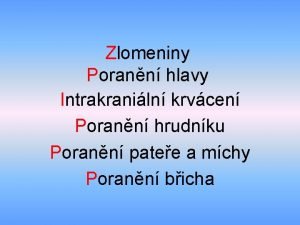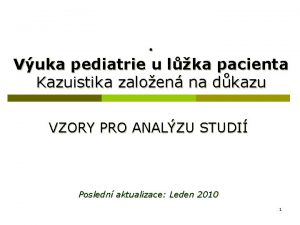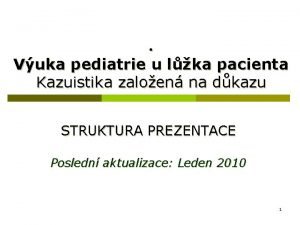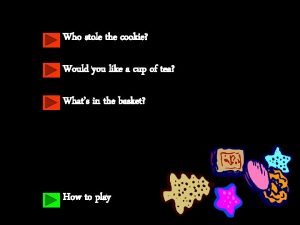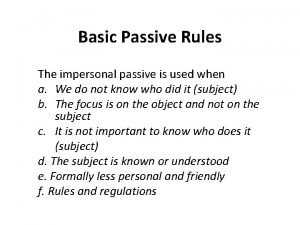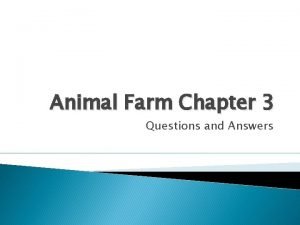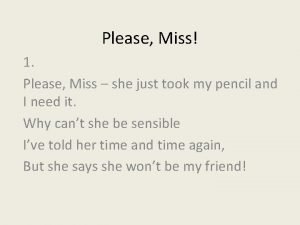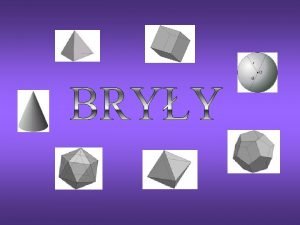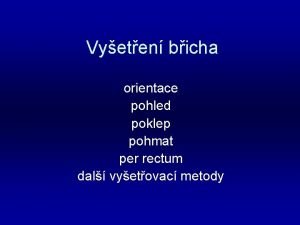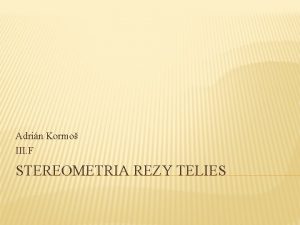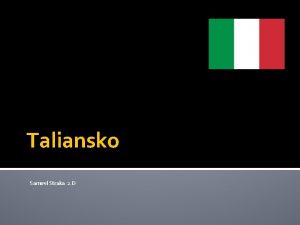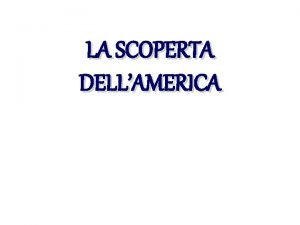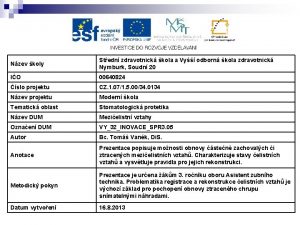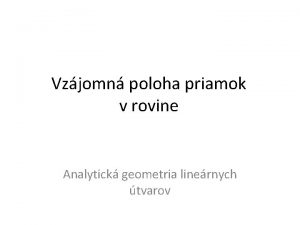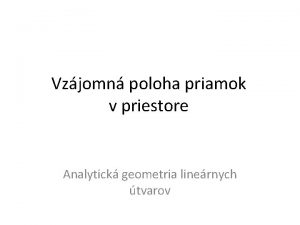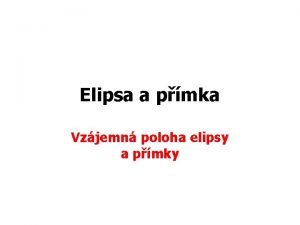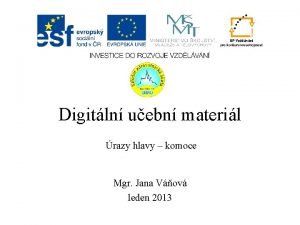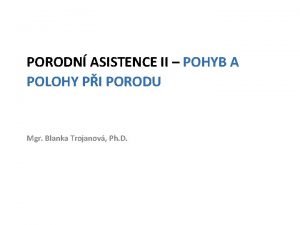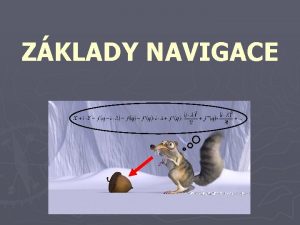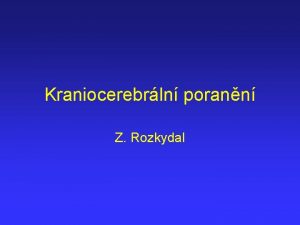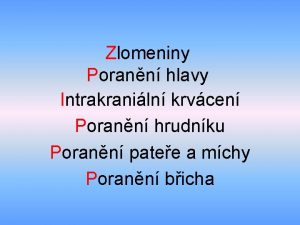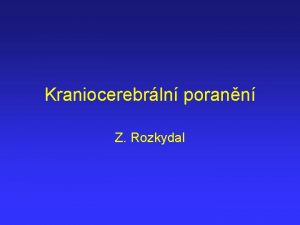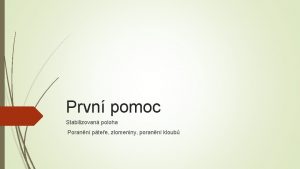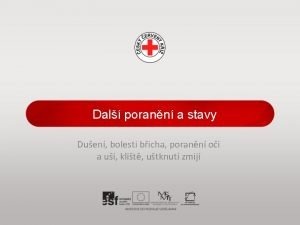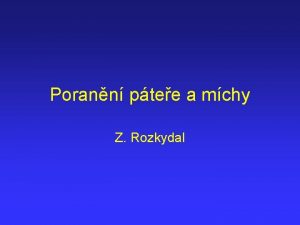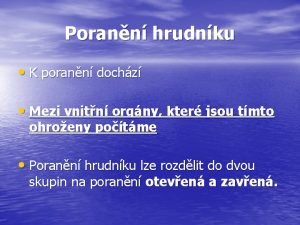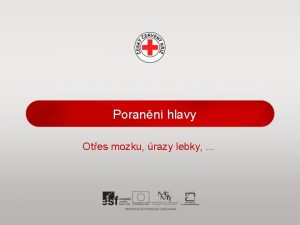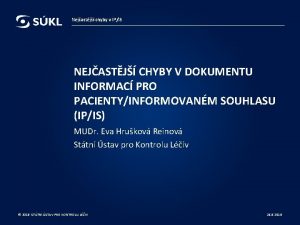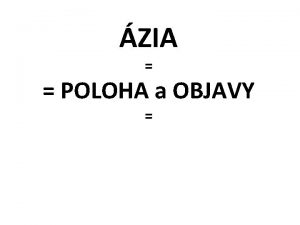Poloha pacienta na op stole Nejastj porann nerv















































- Slides: 47

Poloha pacienta na op. stole

Nejčastější poranění nervů při anestezii

Rizika polohování Poranění nervu je druhou nejčastější příčinou (16%) pojistného plnění v US. Pořadí: Ulnární n. ; brachial plexus, lumbosacral nerve roots, spinal cord. Postoperative ulnar nerve deficits Brachial plexus - sternotomie Risk factors: prolonged surgery, very thin body habitus, and recent cigarette smoking. Infarction or ischemia of one or both optic n. leading to blindness after massive hemorrhage, hypotension, and anemia.

Figure 28 -4 Lithotomy position with less hip flexion for endoscopic procedures such as transurethral resection of the prostate. (Adapted Martin JT. Lithotomy positions. In Martin JT, Warner MA [eds]: Positioning in Anesthesia and Surgery, 3 rd ed. Philadelphia, WB Saunders, 1997, p 50. ) Downloaded from: Miller's Anesthesia (on 12 March 2009 08: 22 PM) © 2007 Elsevier

Figure 28 -6 The lateral position, showing the upper arm rest in position; axillary roll, which supports the chest to free the axilla; and one type of leg positioning. (Adapted from Day LJ: Unusual positions: Orthopedics: Surgical aspects. In Martin JT [ed]: Positioning in Anesthesia and Surgery, 2 nd ed. Philadelphia, WB Saunders, 1987, p 226. ) Downloaded from: Miller's Anesthesia (on 12 March 2009 08: 22 PM) © 2007 Elsevier

Figure 28 -13 The patient is in a semi-sitting position with the knees flexed slightly. The headrest support is fastened to the upper part of the table so that the head can be lowered without changing the relationship of the pinion head holder to the torso. The arms must be supported (not shown) so that the weight of the arm does not stretch the brachial plexus. The buttock area is padded. (Adapted from Martin JT: The head-elevated positions: Anesthesiologic considerations. In Martin JT [ed]: Positioning in Anesthesia and Surgery, 2 nd ed. Philadelphia, WB Saunders, 1987, p 81. ) Downloaded from: Miller's Anesthesia (on 12 March 2009 08: 22 PM) © 2007 Elsevier

Figure 28 -3 Causes of perioperative eye complications are depicted. Corneal abrasions are most common. Swelling or pressure can lead to retinal vein or artery occlusion. Ischemic optic neuropathy is caused by infarction of the optic nerve. Injuries to the optic chiasm can occur during pituitary surgery, and cortical blindness can occur after some cardiac and neurosurgical procedures. (Adapted from Williams EL, Hart WM, Tempelhoff R: Postoperative ischemic optic neuropathy. Anesth Analg 80: 1018 -1029, 1995. ) Downloaded from: Miller's Anesthesia (on 12 March 2009 08: 22 PM) © 2007 Elsevier

Monitorace pacienta monere, "to warn" systematicky kontrolovat. . použitím smyslů a elektronických zařízení opakovaně nebo kontinuálně měřit proměnné anestezovaného pacienta.

Figure 30 -1 Optical illusions. We perceive the circles to be different sizes because we infer the size by relative dimensions. The closeness of the smaller circles makes the inner circle appear smaller, and vice versa. The lines appear to be different sizes because we use straight-line perspective to estimate size and distance. This illusion reportedly does not work in cultures where straight lines are not used. Therefore, our internal perceptions lead us to err in estimating size and length. In the same way, the internal programming of our monitors can lead us to misinterpret results. Downloaded from: Miller's Anesthesia (on 12 March 2009 08: 22 PM) © 2007 Elsevier

Fonendoskop při anestezii okamžitě dostupný. ventilační problém (bronchospasmus) Sp. O 2, Et. CO 2 a EKG detekují problém snadněji než kontinuální poslech. Monitorace fonendoskopem - není-li dostupná elektronická monitorace.

Princip měření NIBP

Figure 32 -2 Effect of cuff size on manual blood pressure measurement. An inappropriately small blood pressure cuff yields erroneously high values for blood pressure because the pressure within the cuff is incompletely transmitted to the underlying artery. Downloaded from: Miller's Anesthesia (on 12 March 2009 08: 22 PM) © 2007 Elsevier

Figure 32 -3 Comparison of blood pressure measurements by Korotkoff sounds and oscillometry. Oscillometric systolic blood pressure is recorded at the point where cuff pressure oscillations begin to increase, mean pressure corresponds to the point of maximal oscillations, and diastolic pressure is measured when the oscillations become attenuated. Note the correspondence between these measurements and the Korotkoff sounds that determine auscultatory systolic and diastolic pressure. (Redrawn from Geddes LA: Cardiovascular Devices and Their Applications. New York John Wiley, 1984, Fig 34 -2. Reprinted by permission of John Wiley & Sons, Inc. ) Downloaded from: Miller's Anesthesia (on 12 March 2009 08: 22 PM) © 2007 Elsevier

NIBP komplikace : bolest Petechie Otok končetiny Venous stasis, thrombophlebitis Peripheral neuropathy Compartment syndrome

IBP, kanylace arterie Continuous, real-time blood pressure monitoring Planned pharmacologic or mechanical cardiovascular manipulation Repeated blood sampling Failure of indirect arterial blood pressure measurement Supplementary diagnostic information from the arterial waveform

Figure 32 -4 Percutaneous radial artery cannulation. A, The wrist is positioned and the artery identified by palpation. B, The catheter-over-needle assembly is introduced through the skin and advanced toward the artery. C, Entry of the needle tip into the artery is identified by the flash of arterial blood in the needle hub reservoir. D, The needle-catheter assembly is advanced at a lower angle to ensure entry of the catheter tip into the vessel. E, If blood flow continues into the needle reservoir, the catheter is advanced gently over the needle into the artery. F, The catheter is attached to pressure monitoring tubing while maintaining proximal occlusive pressure on the artery. Downloaded from: Miller's Anesthesia (on 12 March 2009 08: 22 PM) © 2007 Elsevier

srdeční akce: 49/minutu Figure 32 -1 Digital heart rate (HR) displays may fail to warn of dangerous bradyarrhythmias. Direct observation of the electrocardiogram (ECG) and the arterial blood pressure traces reveals complete heart block and a 4 -second period of asystole, whereas the digital display reports an HR of 49 beats/min. Note that the ECG filter (arrow) corrects the baseline drift so that the trace remains on the recording screen. (From Mark JB: Atlas of Cardiovascular Monitoring. New York, Churchill Livingstone, 1998, Fig. 13 -2. )

Monitorace nervosvalové blokády single-twitch train-of-four (TOF) tetanic, post-tetanic count (PTC) double-burst stimulation (DBS)

Single-twitch 1 Hz. . 0, 1 Hz, kontinuálně

Figure 39 -1 Pattern of electrical stimulation and evoked muscle responses to single-twitch nerve stimulation (at frequencies of 0. 1 to 1. 0 Hz) after injection of nondepolarizing (Non-dep) and depolarizing (Dep) neuromuscular blocking drugs (arrows). Note that except for the difference in time factors, no differences in the strength of the evoked responses exist between the two types of block. Downloaded from: Miller's Anesthesia (on 12 March 2009 08: 46 PM) © 2007 Elsevier

TOF 4 stimuly á 0, 5 s (2 Hz)

Figure 39 -2 Pattern of electrical stimulation and evoked muscle responses to TOF nerve stimulation before and after injection of nondepolarizing (Non-dep) and depolarizing (Dep) neuromuscular blocking drugs (arrows). Downloaded from: Miller's Anesthesia (on 12 March 2009 08: 46 PM) © 2007 Elsevier

Tetanická stimulace bolestivá; 50 Hz na 5 s

Figure 39 -3 Pattern of stimulation and evoked muscle responses to tetanic (50 -Hz) nerve stimulation for 5 seconds (Te) and post-tetanic stimulation (1. 0 -Hz) twitch. Stimulation was applied before injection of neuromuscular blocking drugs and during moderate nondepolarizing and depolarizing blocks. Note fade in the response to tetanic stimulation, plus post-tetanic facilitation of transmission during nondepolarizing blockade. During depolarizing blockade, the tetanic response is well sustained and no post-tetanic facilitation of transmission occurs. Downloaded from: Miller's Anesthesia (on 12 March 2009 08: 46 PM) © 2007 Elsevier

Figure 39 -4 Pattern of electrical stimulation and evoked muscle responses to TOF nerve stimulation, 50 -Hz tetanic nerve stimulation for 5 seconds (TE), and 1. 0 -Hz posttetanic twitch stimulation (PTS) during four different levels of nondepolarizing neuromuscular blockade. During very intense blockade of the peripheral muscles (A), no response to any of the forms of stimulation occurs. During less pronounced blockade (B and C), there is still no response to stimulation, but post-tetanic facilitation of transmission is present. During surgical block (D), the first response to TOF appears and post-tetanic facilitation increases further. The post-tetanic count (see text) is 1 during intense block (B), 3 during less intense block (C), and 8 during surgical block (D). Downloaded from: Miller's Anesthesia (on 12 March 2009 08: 46 PM) © 2007 Elsevier

Double-burst stimulation 2 krátké sekvence 50 -Hz tetanické stimulace, odděleny pauzou 750 ms nerelaxovaný sval – 2 stejně silné kontrakce částečné relaxovaný sval – 2. je slabší

Figure 39 -7 Pattern of electrical stimulation and evoked muscle responses to TOF nerve stimulation and double-burst nerve stimulation (i. e. , three impulses in each of two tetanic bursts, DBS 3, 3) before injection of muscle relaxants (control) and during recovery from nondepolarizing neuromuscular blockade. TOF ratio is the amplitude of the fourth response to TOF divided by the amplitude of the first response. DBS 3, 3 ratio is the amplitude of the second response to DBS 3, 3 divided by the amplitude of the first response. (See text for further explanation. ) Downloaded from: Miller's Anesthesia (on 12 March 2009 09: 47 PM) © 2007 Elsevier

Airway management

Downloaded from: Miller's Anesthesia (on 12 March 2009 09: 47 PM) © 2007 Elsevier

Figure 42 -4 Technique for holding the mask with one hand. An effort should be made to avoid excessive pressure on the soft tissues of the neck. Downloaded from: Miller's Anesthesia (on 12 March 2009 09: 47 PM) © 2007 Elsevier

Figure 42 -6 Technique for holding the mask with two hands. Downloaded from: Miller's Anesthesia (on 12 March 2009 09: 47 PM) © 2007 Elsevier

Figure 42 -11 Intubating laryngeal mask airway (ILMA), illustrating the rigid curve and handle. Notice the different window compared with a standard LMA. (Courtesy of LMA North America, Inc. , San Diego, CA. ) Downloaded from: Miller's Anesthesia (on 12 March 2009 09: 47 PM) © 2007 Elsevier

Figure 42 -13 Insertion of the Combitube. A, The tongue and mandible are lifted with one hand, and the Combitube is inserted in the direction of the natural curvature of the pharynx with the other hand. The printed ring is aligned with the teeth. B, The pharyngeal cuff is inflated with 100 m. L of air, and the distal cuff is inflated with 15 m. L. C, Ventilation is begun through the longer no. 1 tube because placement is usually in the esophagus. D, If ventilation is absent and the stomach is being insufflated, begin ventilation through the no. 2 connecting tube. (Courtesy of Sheridan Catheter Corp. , Argyle, NY. ) Downloaded from: Miller's Anesthesia (on 12 March 2009 09: 47 PM) © 2007 Elsevier

Figure 42 -13 Insertion of the Combitube. A, The tongue and mandible are lifted with one hand, and the Combitube is inserted in the direction of the natural curvature of the pharynx with the other hand. The printed ring is aligned with the teeth. B, The pharyngeal cuff is inflated with 100 m. L of air, and the distal cuff is inflated with 15 m. L. C, Ventilation is begun through the longer no. 1 tube because placement is usually in the esophagus. D, If ventilation is absent and the stomach is being insufflated, begin ventilation through the no. 2 connecting tube. (Courtesy of Sheridan Catheter Corp. , Argyle, NY. ) Downloaded from: Miller's Anesthesia (on 12 March 2009 09: 47 PM) © 2007 Elsevier

Figure 42 -13 Insertion of the Combitube. A, The tongue and mandible are lifted with one hand, and the Combitube is inserted in the direction of the natural curvature of the pharynx with the other hand. The printed ring is aligned with the teeth. B, The pharyngeal cuff is inflated with 100 m. L of air, and the distal cuff is inflated with 15 m. L. C, Ventilation is begun through the longer no. 1 tube because placement is usually in the esophagus. D, If ventilation is absent and the stomach is being insufflated, begin ventilation through the no. 2 connecting tube. (Courtesy of Sheridan Catheter Corp. , Argyle, NY. ) Downloaded from: Miller's Anesthesia (on 12 March 2009 09: 47 PM) © 2007 Elsevier

Figure 42 -13 Insertion of the Combitube. A, The tongue and mandible are lifted with one hand, and the Combitube is inserted in the direction of the natural curvature of the pharynx with the other hand. The printed ring is aligned with the teeth. B, The pharyngeal cuff is inflated with 100 m. L of air, and the distal cuff is inflated with 15 m. L. C, Ventilation is begun through the longer no. 1 tube because placement is usually in the esophagus. D, If ventilation is absent and the stomach is being insufflated, begin ventilation through the no. 2 connecting tube. (Courtesy of Sheridan Catheter Corp. , Argyle, NY. ) Downloaded from: Miller's Anesthesia (on 12 March 2009 09: 47 PM) © 2007 Elsevier

Poloha hlavy a krku při OTI

Figure 42 -3 Schematic diagram demonstrating the head position for endotracheal intubation. A, Successful direct laryngoscopy for exposure of the glottic opening requires alignment of the oral, pharyngeal, and laryngeal axes. B, Elevation of the head about 10 cm with pads below the occiput and with the shoulders remaining on the table aligns the laryngeal and pharyngeal axes. C, Subsequent head extension at the atlanto-occipital joint creates the shortest distance and most nearly straight line from the incisor teeth to glottic opening. Downloaded from: Miller's Anesthesia (on 12 March 2009 09: 47 PM) © 2007 Elsevier

Figure 42 -3 Schematic diagram demonstrating the head position for endotracheal intubation. A, Successful direct laryngoscopy for exposure of the glottic opening requires alignment of the oral, pharyngeal, and laryngeal axes. B, Elevation of the head about 10 cm with pads below the occiput and with the shoulders remaining on the table aligns the laryngeal and pharyngeal axes. C, Subsequent head extension at the atlanto-occipital joint creates the shortest distance and most nearly straight line from the incisor teeth to glottic opening. Downloaded from: Miller's Anesthesia (on 12 March 2009 09: 47 PM) © 2007 Elsevier

Figure 42 -3 Schematic diagram demonstrating the head position for endotracheal intubation. A, Successful direct laryngoscopy for exposure of the glottic opening requires alignment of the oral, pharyngeal, and laryngeal axes. B, Elevation of the head about 10 cm with pads below the occiput and with the shoulders remaining on the table aligns the laryngeal and pharyngeal axes. C, Subsequent head extension at the atlanto-occipital joint creates the shortest distance and most nearly straight line from the incisor teeth to glottic opening. Downloaded from: Miller's Anesthesia (on 12 March 2009 09: 47 PM) © 2007 Elsevier

Velikosti Trach. rourek

Techniky intubace při vědomí intubace s přímou laryngoskopií intubace s nepřímou laryngoskopií intubace ústy naslepo intubace nosem naslepo retrográdní intubace po bronchoskopu

Figure 42 -22 Difficult airway algorithm developed by the ASA Task Force on Guidelines for Difficult Airway Management. (Adapted from American Society of Anesthesiologists Task Force on Management of the Difficult Airway: Practice guidelines for the management of the difficult airway. Anesthesiology 78: 597, 1993. ) Downloaded from: Miller's Anesthesia (on 12 March 2009 09: 47 PM) © 2007 Elsevier

Figure 42 -23 Single-flow diagram version of the American Society of Anesthesiologists (ASA) Difficult Airway Algorithm. +, Always consider calling for help (e. g. , technical, medical, surgical) when difficulty with mask ventilation or tracheal intubation is encountered; ++, consider the need to preserve spontaneous ventilation; *, nonsurgical tracheal intubation choices consist of laryngoscopy with a rigid laryngoscope blade (many types), blind orotracheal or nasotracheal intubation, fiberoptic or stylet technique, retrograde technique, illuminating stylet, rigid bronchoscope, and percutaneous dilational tracheal entry. Benumof 30 offers a complete discussion of these tracheal intubation choices. (Adapted from Benumof JL: Laryngeal mask airway and the ASA difficult airway algorithm. Anesthesiology 84: 686, 1996. ) Downloaded from: Miller's Anesthesia (on 12 March 2009 09: 47 PM) © 2007 Elsevier

Figure 42 -24 Role of the laryngeal mask airway (LMA) in the American Society of Anesthesiologists (ASA) Difficult Airway Algorithm. (Adapted from Benumof JL: Laryngeal mask airway and the ASA difficult airway algorithm. Anesthesiology 84: 686, 1996. ) Downloaded from: Miller's Anesthesia (on 12 March 2009 09: 47 PM) © 2007 Elsevier

Závěr Preoxygenovat všechny = získat několik minut navíc. Vyšetřit všechny = odhlalit některé Několik malých abnormalit může vést až k difficult airway Předpokládej nemožnost ventilace / intubace Měj plán dříve než vznikne problém. Připrav všechny pomůcky Po úvodu nejprve ventiluj, pak relaxuj.

Závěr Lepší je intubace při vědomí nežli hypoxie. Extenze krku a předsunutí čelisti posune jazylku dopředu a zvedne epiglotis. Pokud dolní řezáky lze zakousnout nad horní ret, vysunutí mandibuly může pomoci při intubaci. Vizualizace glotis při vědomí není v anestezii garantována. Nepřítomnost leaku po vyfouknutí balónku glotic/subglotic edém.
 Porann
Porann Single twitch
Single twitch Porann
Porann Vlasy do postupna po plecia
Vlasy do postupna po plecia Kazuistika vzor
Kazuistika vzor Hygienická starostlivosť o pacienta
Hygienická starostlivosť o pacienta Kazuistika vzor
Kazuistika vzor Geminus nerv
Geminus nerv Xotira haqida tushuncha va uning turlari
Xotira haqida tushuncha va uning turlari Anatomija uha
Anatomija uha Podłużne ozdobne serwety układane na obrusie to
Podłużne ozdobne serwety układane na obrusie to What is aphrodite's roman name
What is aphrodite's roman name Cookie monster who stole the cookie
Cookie monster who stole the cookie People believe the company stole over a million pounds
People believe the company stole over a million pounds Stole present continuous tense
Stole present continuous tense Chapter 3 animal farm summary
Chapter 3 animal farm summary Priest vestments meaning
Priest vestments meaning The grinch plot diagram
The grinch plot diagram Stole
Stole Simple past list of irregular verbs
Simple past list of irregular verbs Stole simple past
Stole simple past Miss & she
Miss & she How raven stole crow's potlatch
How raven stole crow's potlatch Ułożenie sztućców
Ułożenie sztućców Obrotowe sześciany, obrotowe kostki wiedzy
Obrotowe sześciany, obrotowe kostki wiedzy Narysuj swoją rodzinę przy stole
Narysuj swoją rodzinę przy stole Nshss graduation cord
Nshss graduation cord Courvoisierovo znamení
Courvoisierovo znamení Rezy telies
Rezy telies Sečnica kružnice
Sečnica kružnice David straka
David straka Poloha indie
Poloha indie Rovnovážná poloha
Rovnovážná poloha Poloha savany
Poloha savany Geografická poloha sydney
Geografická poloha sydney Norsko poloha
Norsko poloha Fotbalova poloha kojeni
Fotbalova poloha kojeni Pawlikův hmat
Pawlikův hmat Fowlerova poloh
Fowlerova poloh Subnasale
Subnasale Vzajomna poloha 2 priamok v rovine
Vzajomna poloha 2 priamok v rovine štrkovka leopoldov
štrkovka leopoldov Priesečník priamok
Priesečník priamok Pmka
Pmka Antitrendelenburgova poloha
Antitrendelenburgova poloha Genukubitální poloha
Genukubitální poloha Ligamentum conicum
Ligamentum conicum Poloha kde jsem
Poloha kde jsem


